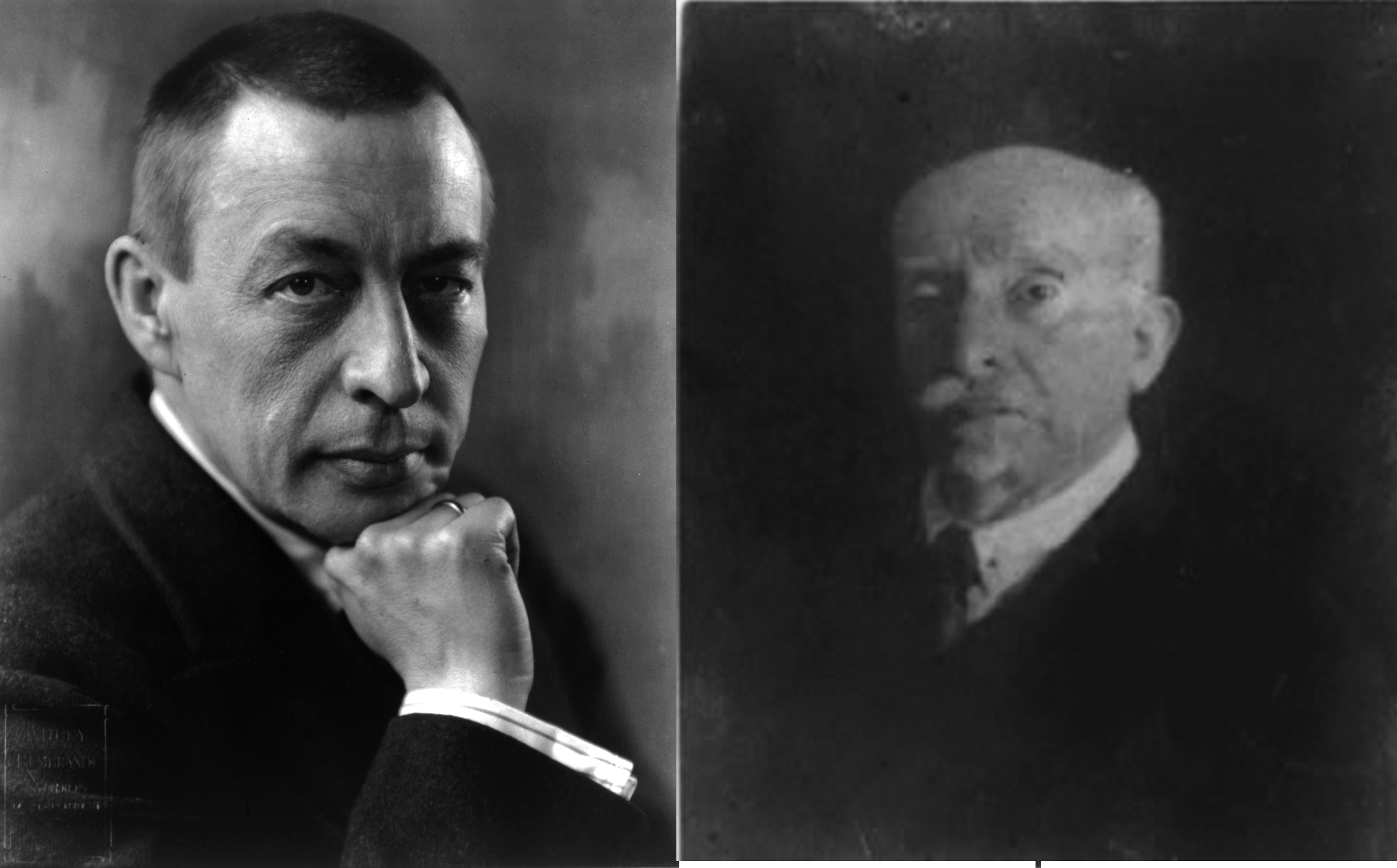It comes as no surprise that there is a connection between the arts and hypnosis. The state of trance plays a vital role in the creation and experience of the arts. In some cases, the hypnotist can be a vital aid to an artist when developing their creativity, resolving a creative block or coping with stress. Trance can also aid in the appreciation of the arts.
Sergei Rachmaninoff and Dr. Nikolai Vladimirovich Dahl
Being an artist can be a difficult path, requiring devotion and sacrifice for often minimal living standards and security. By nature of the discipline, they need to be open and sensitive to convey the human condition within their work however are also required to have a thick skin, emotional strength and resilience to continue to work under such financially difficult or critical conditions. While constructive criticism can be used to improve one’s artistic practice, it is understandable why it could also cripple an artist who is facing many challenges due to this choice of profession. This is why artists need to develop mindfulness and especially resilience as part of their artistic practice which is where the hypnotist can assist.
One such case is with the composer, Sergei Rachmaninoff ( April 1873 – March 1943), who after receiving much negative criticism about his work, spiralled into a depression which lasted 3 years and turned to hypnosis for assistance. During the time of his depression he continued to perform and conduct but hit a creative block [4]. Dr. Nikolai Vladimirovich Dahl (July 17, 1860 – 1939) was a Russian physician not only interested in the benefits of hypnosis but, also was an amateur violist, giving him a deeper appreciation for and experience of the arts. Being experienced in the arts gives one a unique perspective as to the challenges the artist’s lifestyle presents. Dr. Dahl began to see Rachmaninoff in January 1900 giving him positive suggestions such as “You will begin to write your concerto,” Dahl told Rachmaninoff. “You will work with the greatest of ease. The concerto will be of excellent quality.” [4] The sessions were not only focused on creating music, they were also focused on getting good sleep, improving mood and confidence building [3]. It is important to acknowledge the “practice” of an artist isn’t just about art making but, also their entire being and wellness. Artistic creations convey the mental, emotional and spiritual state of the artist therefore, it is important for them to take responsibility of self care. Developing the skill of entering into trance assisted Rachmaninoff’s wellness and he began composing again that summer. He subsequently dedicated one of his most well known pieces, “Piano Concerto #2 in C Minor” to his hypnotist with gratitude in May of 1901 [4]. What is fascinating when listening to this piece is the circular motives within the rhythms; the piece is almost trance inducing within itself; almost as if a personal nod to the methods of Dr. Dahl.
Another benefit of an artist working with a hypnotist is that to become skilled in the closely related states of art-making and trance. Visual artists often speak of a state of mind that is ideal when creating art and that one of the signifiers is that one looses track of time. Many surrealist and abstract expressionists artist have referenced the importance of automatic painting, the subconscious and trance in the creation of their work. A hypnotist can also use trance assist in the appreciation of the arts for the viewer. Bringing viewers into a state of trance while viewing artwork can assist in bringing them a more heightened experience and receive more insight into a work. With this in mind, organizations should hire hypnotists to prepare a crowd before hearing a symphony concert or entering an art gallery. In the article, "You Can Now Tour the Barnes Collection with a Shamanic Guide in Your Ear,” Meredith Mendelsohn discusses how the artist, Andrea Hornick synthesizes trance and drumming with an art tour of the Barnes Collection in Philadelphia. Titled “Andrea Hornick: Unbounded Histories” this hybrid of performance art, hypnosis, and art tour, guides the viewer with a narrative Hornick created while connecting with the collection through trance. Hornick synthesizes the spiritual and intellectual in within her trance performances. While it may not be the traditional historical notes on each of the artworks, Hornick describes them as “transformative information” allowing for another type of experience that enriches the work [2]. This particular example doesn’t just induce trance for the viewer but, creates the narrative content to deepen their experience with art. It is also possible to have the viewer simply experience trance while looking at artwork and they will experience their own visions similar to Hornick.
The artist’s hypnotist is an important individual to assist in developing one’s creativity, resolving a creative block, coping with stress and becoming better skilled at entering into the art-making state of trance. It is such a vitally important skill for creatives that this article would argue that hypnosis should be part of art schooling; appreciation, creation and self care for the artist.
~ Deanna Blue
Sources:
Lewis, Susan. “How Hypnosis Helped Rachmaninoff Compose His Beloved Piano Concerto No. 2.” WRTI 90.1. October 30, 2017. http://wrti.org/post/how-hypnosis-helped-rachmaninoff-compose-his-beloved-piano-concerto-no-2
Mendelsohn, Meredith. "You Can Now Tour the Barnes Collection with a Shamanic Guide in Your Ear.” Jan 3, 2017 6:31 pm.https://www.artsy.net/article/artsy-editorial-you-can-go-artist-induced-spiritual-trance-barnes-collection
Niels, Elger. “Nikolai Dahl’s Cure - Good Luck or Good Practicing.” Rachmaninoff Network. October 14 2003.https://www.rachmaninoff.org/articles/archive/20-nikolai-dahl-s-cure-good-luck-or-good-practicing?showall=1&limitstart=
Sokol, Tony “AFTER REVIEWERS RAVAGED SERGEI RACHMANINOFF ,THE COMPOSER TURNED TO HYPNOSIS”, Posted on Hypno Cloud: November 22, 2015. http://www.hypnocloud.com/news/2015/11/22/after-reviewers-ravaged-sergei-rachmaninoff-the-composer-turned-to-hypnosis

